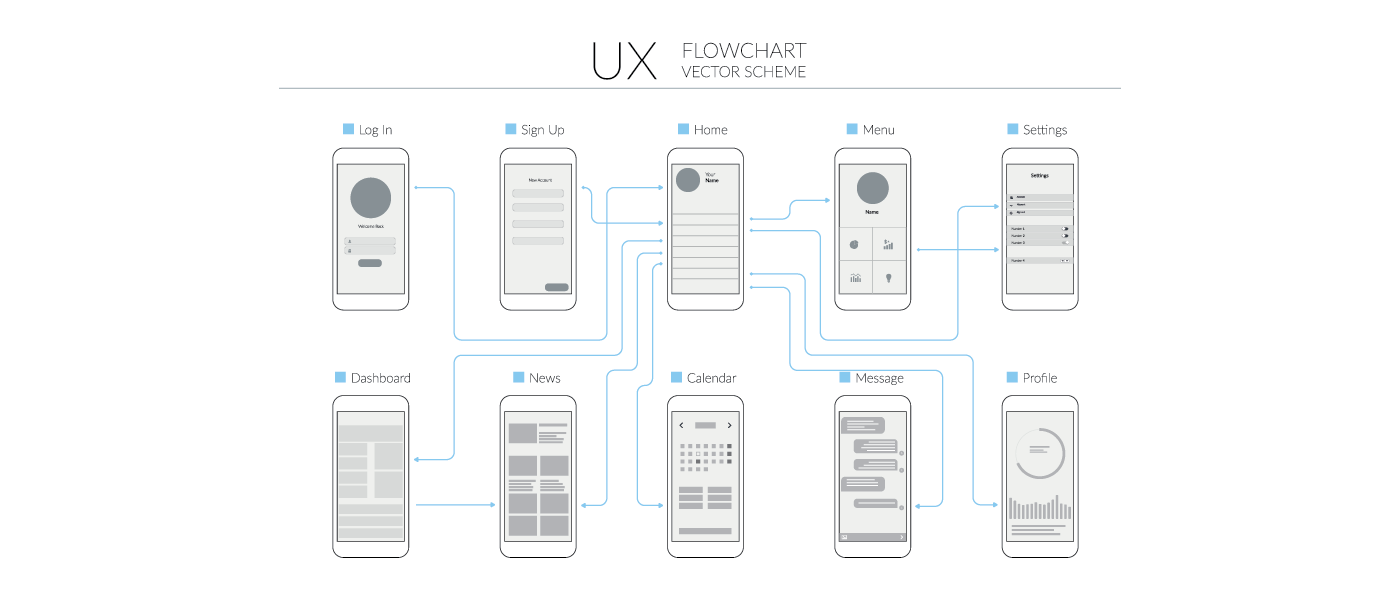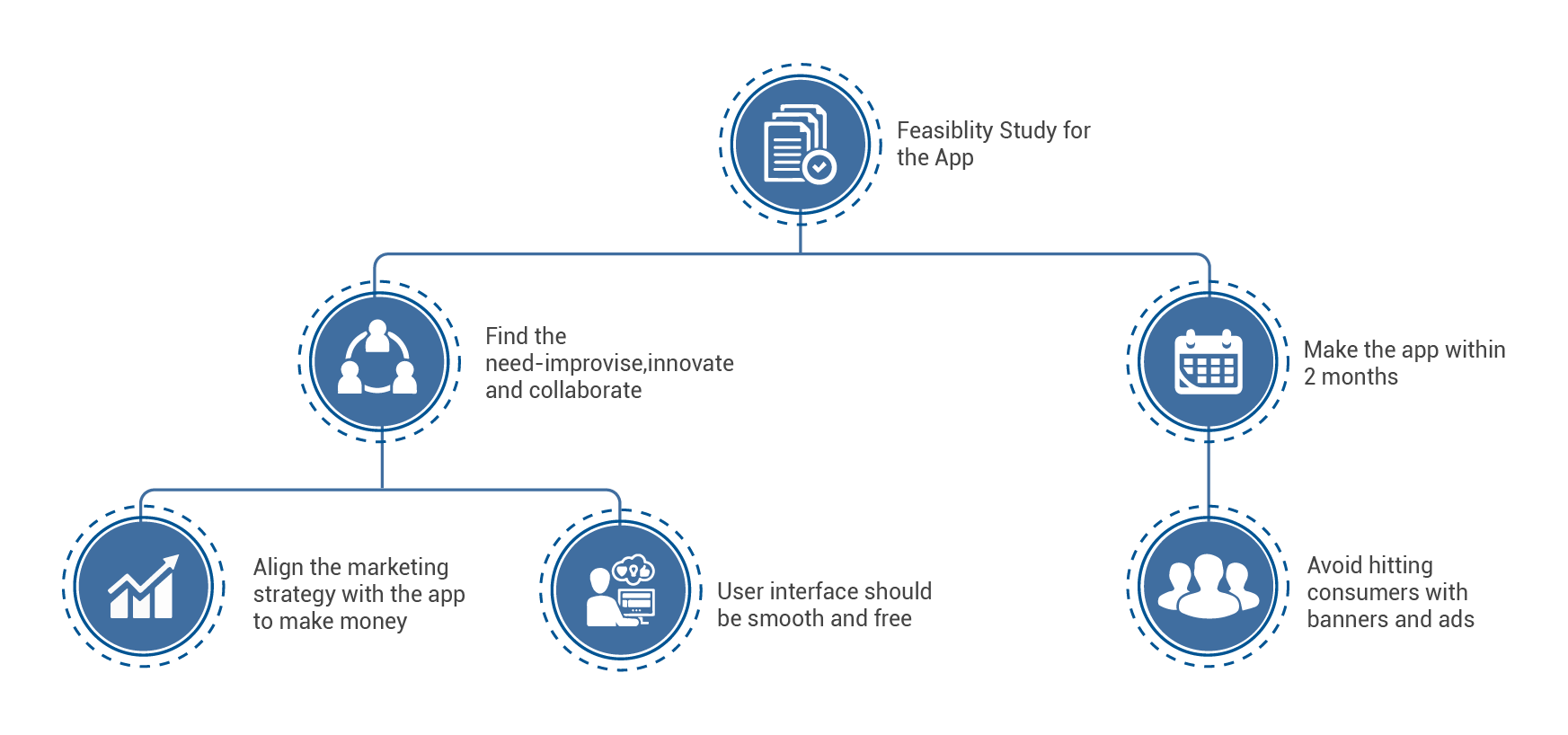Category: Mobility
Nearly 2.6 billion people across the world today have access to a high-powered smartphone, at all times, and seven out of every ten people will have access to a smartphone by 2020. Android phones constitute a bulk of such devices. Businesses are slowly but steadily discovering the merits of rolling out an outstanding Android app to improve branding and customer engagement. A well-designed app allows the brand to communicate the brand message effectively, and develop a sustainable relationship with the customer.
Here are the ways in which a standout business app allows an enterprise in branding and customer engagement.
Delivers a Streamlined Experience
Enterprises need to be able to assess and refine the usability of the app and identify pain-points such as why high volumes of app downloads are not converting into customer registrations or conversions. They need to quantify the impact of the app experience on the customer’s overall brand perception. 
Making things simple and easy for the customer is a sure-shot way to raise the value of the brand in the eyes of the customer. Brands need to identify pain points in customer interactions and work to mitigate it in all earnest. Rolling out an app invariably helps the enterprise streamline their engagement with the customer.
The best apps are highly focused, based on delivering a specific or much sought-after functionality for the user. For instance, the app could make it easy for customers to interact with the brand, offering an easy way to search the FAQ, do self-service, get in touch with customer support, and more. Such an app plays into today’s overriding sentiment of instant gratification.
An app could also be used as a single point access to the social media pages and other digital assets of the brand.
The best app encourages active feedback and co-opts such feedback in newer versions of the app, with a central focus on improving customer experience and delivering more value to users. An app not updated frequently creates potential compatibility issues when the mobile operating systems are revised, and moreover, users are reluctant to risk downloading or using something seemingly abandoned.
How Business App Offers Proactive Communications
Unlike a website which the user has access every time by typing in the URL, an app once downloaded remains in the user’s phone, and may be accessed conveniently, even when offline. 
When a customer installs an app, the business may send notifications directly to the app, bypassing the often-ignored email inboxes. Such push notifications gain high visibility and also allow the brand to reach out to the customer on a 24×7 basis.
Push notifications are invaluable in grabbing customer’s attention, even when users do not actually use the app. Push notifications boost app engagement by a whopping 88%, with Android users way more receptacle to such notification compared to iOS users. The best push notifications, with the highest click-thru rate, are personalized and contextual, such as being based on the product last viewed by the user, including the user’s name, and co-opting other nuances.
Today’s consumers want information within seconds, and service in double quick time. Very few take the pains of seeking out the brands’ website or social media page. If the customer can be persuaded to download an app as a one-time effort, the brand can easily push the required information and engage with the customer proactively. Customers can get the required information or make the purchase equally easily, creating a win-win situation.
Delivers Deep Customization
The most successful customer-facing apps personalize the user experience. The business co-opts emerging technologies like near field communication (NFC), artificial intelligence (AI) and machine learning to understand the user’s choices and preferences.
Smart marketers leverage the apps location tracking capabilities, beacon and geofencing technology to send location-specific, contextual, and timely data-driven content to customers. A case in point is leveraging beacons to push location-based offers and promotions, promote loyalty programs, and facilitate mobile-based proximity payments.
The Pew Research Center estimates nine out of ten smartphone users in the USA enable location services on their mobile phones.
Complements Brick and Mortar Buying
Many retail businesses now offer apps to can enhance customers’ in-store experiences. The app could, for instance, allow the user to scan the barcode of the product, to check availability, different variants, price, product reviews, and other information. Some businesses also offer the possibility of adding the item to the cart and even ordering the item online, sparing the hassles of queuing up at the till or even carting the item home by oneself.
Customer facing apps go a long way in delivering a consistent and seamless omnichannel experience for the user and integrate the physical and digital world.
Businesses could take a cue from 2016 Coachella music and arts festival, where fans who downloaded the app received out location-based notifications about artists and vendors to attendees, and offered beacon-enabled mobile payments to attendees, sparing the need for a physical wallet.
Another success story worth benchmarking is Domino’s Pizza’s new mobile app which allowed customers in the UK to order delivery or in-store pickup. The app has been downloaded more than 10 million times and resulted in a 24.4% increase in e-commerce sales.
Brands, however, cannot afford to rest on their laurels of having successfully coaxed customers to install their apps. The app itself needs to be updated regularly, co-opting new content and features. App developers also need to remember users are doing the brand a favor by installing the app on their smartphone. The brand should not misuse the generosity by taking up too much space causing the system to hang, or offering vulnerabilities which allow potential hackers access to the smartphone. It takes the services of a sound a competent developer to create sound and robust apps which offers real value to users.
Stay up to date on what's new

Featured Blogs
Stay up to date on
what's new



Talk To Our Experts
Computers are getting faster and smarter with each passing day. It has been spearheaded in a direction where computers are taught to mimic natural human intelligence, a concept and now a reality known as Artificial Intelligence (AI). Since its coinage in 1956, AI has been predicted to lead computing for automating and substituting all human processes, particularly in the industry and commerce.
Processes like supply chain management, which needs relentless focus and labor in all its operations can benefit deeply from the use of AI. With the developments in AI moving at breakneck speed, companies have already invested in AI for managing their supply chain. The result is complete automation from production to delivery along with an overall improvement in efficiency and speed.
The application of AI has made the entire process of supply chain management more streamlined and accurate. It takes human labor out of the process, which is one crucial aspect companies look forward to reducing costs and errors. Meanwhile, AI is proving advantageous to other areas of supply chain management as well, which resulted in more companies adopting it into their workplaces.
Let’s digress a bit to talk about what artificial intelligence is about. Artificial intelligence is about taking the capabilities of Machines in terms of Intelligence beyond the monotonous processes, and adding a dash of autonomy to the decision-making capabilities. The advent of artificial intelligence has expanded the capability of automation and technology and has forayed into a Territory of operations that was once reserved only for human beings.
When it comes to the application of artificial intelligence, many industries and segments have benefited from it. One among those is the domain of supply chain management. Supply chain management is gaining importance by the day going to the disappearance of Geographic and physical borders when it comes to transactions.
As inferred by Gartner, the application of artificial intelligence in the field of supply chain management can be broken into two categories:
Augmentation: 
Augmentation is really a sophisticated word for addition. Artificial intelligence is seeing its uses even in everyday activities like setting an alarm using personal assistant like Google Assistant or Siri. This kind of Artificial Intelligence can be used in spaces where the guy does not have complete control over the outputs, but rather augments the human effort with some intelligence that needs to be essentially gathered from monotonous tasks.
AR has transformed the software used in supply chain management. AR help truck drivers, warehouse workers, and management keep track of products by overlaying information onto the real world. Augmented reality is used efficiently in “pick and pack” service. In a large warehouse, AR enables to locate products easily and pack them. Logistics robots can easily scan a product for damage, check its weight and adhere to package shipping instructions.
Automation:
Automation seems to be the password in every industry. There are certain instances where the process is so simple that Artificial Intelligence can take over the entire process including the final output. This completely eliminates the need for human intervention. With this elimination of human intervention, the probability of error is also greatly reduced. One fine example would be the implementation of robots in performing a few key steps when it comes to the manufacturing industry.
The future of supply chain management How will technology and AI shape tomorrow [Source: University of Liverpool Online]A few specific aspects in which Artificial Intelligence can assist in supply chain management are:
Using chatbots: 
We have been using the internet as a communication medium using instant messengers for a while now, and the conversation generally starts with a templatized set of questions. These templatized questions and the conversations surrounding them can be automated using a chatbot. Chatbots help in streamlining the procurement related tasks through automation and augmentation. These chatbots can be used to help with the initial steps of procurement. The information that we receive from this chatbots could also help determine the validity of the leads.
Chatbots can be used to automate numerous tasks especially in communicating with the customers via direct calls or text messages. The advancements in chatbot programs have enhanced their communication abilities, which have made them useful aids for a variety of tasks besides answering calls or queries. Most chatbots are able to place purchase request, conduct research, answer questions, file and document invoices alongside communicating with the customers.
Supply chain planning and machine learning:
Machine learning is the technological twin of artificial intelligence. Intelligence can only be achieved by learning, and if machines have to be intelligent, they have to learn automation. Supply chain management can incorporate machine learning, even if not for execution, at least for planning. Machine learning can help in a variety of aspects in supply chain planning.
Machine learning can help with the forecasting of inventory based on demand and supply. Facilitating the machine to learn with the right segments of data could also bring in a revolution in terms of agility and optimization of even the decision making processes in supply chain management. Teaching the human beings something is an arduous task -stitching machines the same thing only makes it a little bit more challenging. However, you can expect the Machines to learn things a bit faster and get more accurate with the time then you can expect human beings to be!
Machine Learning for Warehouse Management: 
Warehousing is an integral part of any Logistics Company, and it requires a good understanding of the inventory, the demand, the supply and the challenges in facilitating a smooth transition between the two ends to be successful in the field of Logistics.
Machine learning and artificial intelligence come in handy at this juncture, because the planning and Management for warehousing depend on the intelligence that can be gathered from the data. The data can analyze vital pointers, including the supply floors like overstocking or understocking, and even the kind of inventory that we are looking at, including the attributes of longevity and susceptibility to damages when in storage.
Natural Language Processing for Data Sanitization:
The last couple of aspects that we have been looking at talks about data point data is very important to make calculated decisions. If the data is not like it, the decisions might not serve the purpose of being beneficial for the business. Therefore, it is essential to ensure that the data is clean and business-worthy.
Natural Language Processing, commonly abbreviated as NLP, is an element of artificial intelligence that takes care to decipher foreign language data, and streamline them in a way that it can be used for data processing. With the humongous amounts of data that the logistics industry Encounters, it is important to sanitize the data before it can be used to make important business decisions. The aspect of Natural Language Processing develops with Machine Learning and artificial intelligence.
Related Webinar : Artificial Intelligence in layman’s termsAutonomous and Self-Driving Vehicles:
Thanks to the innovations by Elon Musk and the automobile company Tesla, self-driven cars are no longer an element of science fiction. Self-driving vehicles have started to take over the realm of montane transportation. If there is one territory where this advancement can make a significant impact, it has to be in the field of logistics and shipping.
Driverless trucks might be in the nascent stages of development, but the progressive only point towards a positive conclusion. If driverless trucks are introduced, it can overcome a lot of hurdles, especially with respect to the mandatory crest that humans require. The laws in most of the countries mandate that drivers can only engage in 11 hours of break-free drive. With driverless trucks stepping in, the driving can go on effectively for 24 hours, and it will definitely reduce the cost by at least 25%.
With the advent of e-commerce on both B2B and B2C fronts, logistics is only gaining more importance by the passing day. A lot of eCommerce companies depend on the data from the logistics service providers to make more calculated decisions. By incorporating the latest in the world of Technology like the concepts of machine learning and artificial intelligence, it would not be right to say that the logistics industry would be far ahead of its time, because, in today’s world of rapidly changing advancements, it is important to be technologically advanced to even stay in the race!
Stay up to date on what's new

Featured Blogs
Stay up to date on
what's new



Talk To Our Experts
Any client needs to know how a proposed app is likely to work and impact their business. It will provide them with an insight into the functionality of the app and how it helps the end users. This is where wireframing comes into play as an essential part of mobile app development. A professional app development company can use wireframing as an essential tool for laying out the functionality, visualization, navigation, UI and preliminary function of an app.
Wireframes have a significant role in the design process. As yet, wireframing has been the most effective way to detect usability issues early on in the design process. Wireframes typically do not include color, graphics or stylized fonts so that the reviewer is least distracted and focused on the user flows and user experience. In what follows, we will highlight why wireframes constitute a vital part of the app development process.
App Designers consider Wireframing an Ideal Building Block
 Wireframes are essentially a visual conception that illustrates the screen interface of an app. Usually conceived as black and white layouts, the wireframes outlines how different elements of the app like pages, navigation, and conversion portions are laid out. As a blueprint, a wireframe ensures the level of attention in design and UI so that it remains practical for the end user.
Wireframes are essentially a visual conception that illustrates the screen interface of an app. Usually conceived as black and white layouts, the wireframes outlines how different elements of the app like pages, navigation, and conversion portions are laid out. As a blueprint, a wireframe ensures the level of attention in design and UI so that it remains practical for the end user.
It lays out the skeleton of the app which portrays the page‘s interface (elements spacing, content prioritization, and functionalities) and how users interact with the site. Wireframes act as the vital link between the information architecture and the visual aspects of the design.
Moreover, wireframes act as a visual representation of how the user manages different scenarios and achieves the business objectives. It acts as a site architecture with links provided in each of the wireframes so that a clickable model is built for getting a full demo experience of the app.
Wireframing is the stepping stone for an app to become successful, which also have numerous other benefits.
How to Create a Wireframe [Source: SmartDraw]Wireframing Tools – Key to Navigating the Flow of the App
A wireframing tool will help you understand how to create an app or website essentially easier by visually paring the product down and focus on the functionality and user interactivity of your product.
Clients need to be educated on how your proposed app or website will work. A written or verbal explanation would leave major functionalities down to their imagination, giving way to more errors. This situation is not helpful for you or your client. It is here that wireframing tools can play a significant role in squaring that circle.
Wireframing tools differ with varying levels of functionality some of which can be used purely for simple wireframes, while others to create a working prototype. Some wireframe tools take you through the entire process of roughly sketching your wireframes, creating sitemaps, flowcharts, and storyboards; collaborating them with others, and building functional prototypes.
The Boons of Wireframing in App Development
What wireframing does is to create a visual framework of the entire app. It steers clear from complex flowcharts by substituting with an understandable model that eases the workflow and accelerates the app development process. The following is a check-list of the benefits of using wireframing in application development: 
- A Walkthrough of the App
The blueprint of the app laid out through wireframes will give the client a clear picture of what the app is about and its functionality. Using wireframes, the client can suggest changes or improvements so that the final app design remains in accord with their goals. A proper wireframe is essentially a walkthrough of the app that guides the clients and developers to focus on building the app solely with the end user experience in mind.
- Improves Development Process
Wireframes aid real-time communication within the team, which helps speed up the development process. It eliminates design errors as the wireframes can provide insights into the workflows to be used by each section of the development team. The improved app workflow helps the team to focus on the responsiveness of the app using regular feedbacks. Such a method is very useful if a deadline is looming large.
- Aids Interactive Apps
Some apps need good animation display such as in case of a gaming app. An interactive app requires a blueprint for visualizing all the ideas, designs and features. Wireframing allows just that as it gives developers the means to preconceive the visual and moving elements within the app. This will give them an estimate of how the interactive elements of the app functions and the effect that it has on the user experience.
- Allows Easy Changes
With a wireframing tool, it is easier to make the necessary changes during the app development process. The wireframing model allows the clients to suggest the necessary changes during the actual development. Developers can then work on these suggestions easily by making the relevant changes to the app. Any changes made will instantly reflect in the app, which allows the development team to implement the client suggestions right away.
- Minimizes Overall Project Costs
Having a good wireframe for an app can cut down the costs involved in its development significantly. The client can request the necessary changes when previewing a demo of the app through the wireframes. This prompts the development team to work on these changes in the initial stages of building the app. Changes or additions during the final stages usually prove costly. A wireframe eliminates this and quickens the process of making the app ready for the launch.
Building a great wireframe
At Fingent, wireframes are a complete reflection of our client’s unique requirements. Our team makes it a point to understand our clients not just from a technical perspective but from an emotional perspective as well. This helps us address their requirements better so that the end results always remain fruitful. For that purpose, we employ a standard process of wireframing to build apps with rich user experience and responsiveness. Here are the major steps involved in our wireframing process:
- Understanding the client – Getting to know what the client wants from a technical perspective helps us in determining the right solution for them. But we go an extra mile to understand the client from an emotional perspective as well so that we can serve them better and do more than just provide a technology solution. We get to know what exactly is in the minds of our clients, which helps us in being proactive in our approach.
- Understanding the outcome – The first step in creating a wireframe is understanding what our client intends to do or convey through a particular app. That is, what the client wants his/her users to do. It includes finding out whether the client wants its users to do a particular action or read a particular thing or even feel a particular way after going through the page or app section.
- Creating user stories – We then create user stories which cover the list of features required in the application and also a brief description of the flow and functionality within each section. This helps us better in knowing what to use and where it is placed like whether it is best to use a checkbox or a radio button for a particular element on the page or to have a text box or drop-down menu for another element etc. While creating the wireframes, this can act as a quick reference.
- Designing the wireframes – After obtaining the required inputs from our clients, we then proceed with creating the wireframes by using a stencil kit or other simple wireframing tools depending on the complexity of the application. The wireframes that we create using this method are shared with our clients as well as our designers so that everyone can come up with better ideas and solutions.
- The user interface – While we go about the process of wireframing, we always keep in mind our client’s unique requirements. But we also make it a point to put ourselves in the shoes of the users of the app as well. This helps us understand and answer many questions that the users might have in their minds while going through the app. Together with the valuable inputs from our client, we create apps that are more user-friendly by applying the necessary changes. We preoccupy ourselves with questions during development such as ‘What does the user want?’ or ‘What will the user think?’ What we primarily ask ourselves while wireframing for apps and web pages is ‘What does the user want?’ or ‘What will the user think?’ with the aim of leading the users to what our client wants them to do.
Summing Up
In a nutshell, a good wireframe is a simplified visual concept of the future app. But they can also wreck a project if not done correctly. It helps build a mockup of the proposed app that contains its would-be features and functions.
It doesn’t give any idea about the design but helps to understand the functionality of the application, which is its definitive advantage. It enables the client, developer, and designer walk through the structure of the app without being distracted by colors or graphics.
Even though wireframing could take up some time before the development of the solution, it is always better to make your wireframes perfect and then get into development. At Fingent, we make it a point to wireframe every section of any app, as it is much more meaningful and safe for development later. Our experts assert the importance of wireframing as it allows in creating flexible workflows for easily incorporating changes. Moreover, it simplify the process for the developers and designers to begin executing once the core features and elements are confirmed.
Throughout the process of wireframing and development, we believe it is best to keep in touch with our clients on a regular basis. In this way, we are able to keep them updated on the developments and gather feedback to make sure that it ultimately meets their requirements. This approach not only helps us in our projects but also in building solutions that truly matter to our clients.
Stay up to date on what's new

Featured Blogs
Stay up to date on
what's new



Talk To Our Experts
The worldwide enterprise mobility market is growing by 24% GAGR, and its value will likely touch $140 billion by 2020. A key contributor to the growth is Android. However, enterprise seeking to leverage the gains of Android-powered mobility, however, needs to roll out intuitive Android apps, through which they can channel the ecosystem to the desired effect.
Here are the benefits enterprises stand to leverage by investing in Android apps
1. Android Cut Costs
Android is open-source. Its Software Development Kit (SDK) is available free of cost. Enterprises rolling out Android apps to power their systems and processes need to spend only on the development costs. They can minimize the software licensing costs, and get their software free of any royalties. The saving is considerable, considering CFOs in today’s highly competitive age are penny-pinchers, and reluctant to invest in anything not directly contributing to the bottom-line. 
2. Android facilitates Easy Integration
Most enterprises have multiple entities, departments, and processes. Having separate and distinct systems or processes for each entity needlessly duplicates the efforts and costs needed to maintain such systems, and also creates disjoints and data silos. Many enterprises strive to run company processes through a single integrated system. Android is the perfect platform for such an approach, as is is resilient, and able to run on any device or form factor. An enterprise can easily develop a CRM on Android and seamlessly link it with an Android developed a marketing automation suite, a Human Resource Information System, and more, creating an integrated whole. Such an approach ends the menace of data silos and facilitates the smooth and seamless flow of information across the enterprise.
A comprehensive Android-based platform is a convenient way to manage all functions of enterprises. The enterprise can roll out several functional apps, each linking to the integrated system. Such apps, which sits over the traditional enterprise systems, and which updates the systems in real-time, may be tailored to suit the workflow and process of the employee or the department. It gives an unprecedented level of flexibility to the employees and makes the enterprise adapt to respond to changes faster. For instance, if a particular situation requires a new workflow or a new level of coordination, all the enterprise needs to do is roll out a new app and disseminate it to the concerned employees or stakeholders.
3. Android Delivers Flexibility
Many-a-times, enterprises are forced to adjust their business operations to cater to the demands of an inflexible system. The ease and low costs to develop Android apps, and the flexibility of the Android platform mean enterprises need not make such sacrifices and can pursue their objectives in the most efficient way possible. Android makes it very easy and viable to develop tailor-made, and even innovative apps to suit any processes or any requirement. Custom apps may also be localized to maximize productivity.

4. Ease of Installation and Use
Developers have it easy with Android, thanks to the availability of Android tools which offer easy ways to improve, fix, and update apps thanks to the facilities that Android tools provide them.
Android applications are flexible and resilient to be published and pushed in multiple ways. It may be hosted in an app store, or even distributed through APKs. Enterprises can easily ensure their employees, customers or other targeted stakeholders can access and download the app in a very simple way, without any hassle. Unlike other stacks, which require a lot of learning curve and even set-up assistance, Android’s simple and easy nature makes it a DIY proposition.
Android brings very few complications or compatibility issues. Custom built Android apps, designed with end-user requirements in mind offer very little complication and syncs seamlessly with any business software, including legacy systems. The open source nature also means the availability of several connectors to link enterprise applications with popular packages such as Salesforce, MailChimp, and more.
Bizness Apps – “Mobile Apps For Businesses Made Easy” [Source : Flikli]
5. A Fillip for BYOD
The Bring your own Device (BYOD) concept is a rage in enterprises. A big reason for its popularity is the win-win proposition it offers to both the enterprises and the employees alike. Enterprises save on hardware and training costs, whereas employees get the convenience of working in their own familiar devices, with the associated productivity benefits. However, the success of BYOD depends on the availability of highly functional apps, through which employees can access their work. Logging in to the corporate intranet through a mobile browser every time is highly cumbersome and in any case, an inefficient way to work, frittering away much of the gains of mobility.
Android apps allow the employee to work seamlessly. It allows the enterprise to set policies to ensure BYOD does not compromise the integrity of enterprise data and processes.
With BYOD, employees, especially those on the move, can access enterprise applications securely through the API, and from their usual device. This expedites the decision-making process, makes work seamless, and saves the executives’ effort.
6. Valuing the Stakeholders
Forward-looking enterprises of today share some common traits, and being responsive is one such trait. Enterprises which are responsive to its stakeholders, promote an open culture, and encourage feedback, gain a positive image, and reap rich indirect benefits out of it. A collaborative software development approach, with end users and other stakeholders having a major say syncs with such a culture and environment.
Android is the perfect medium for such a culture and approach. The large and vibrant Android community makes it the perfect option to receive customer feedback. Users of an Android app can easily share their feedback and even rate the app in the Play Store. Several freely available tools make collaboration easy.
7. Improved Customer Engagement
While mobile apps revolutionize the internal workings of an enterprise, its potential to boost customer engagement stands underrated.
Mobility is clearly the future, with more people already accessing the Internet through their smartphones than through traditional computing devices such as PCs and tablets. Among the various mobile platforms, Android is the dominant player, with 84% of the total mobile market share. Android’s dominance is unlikely to end anytime soon either. Enterprises investing in customer-facing Android apps, and promoting customers to download it to their smartphones, stand the chance of establishing a secured and reliable engagement channel with the maximum number of customers.
Stay up to date on what's new

Featured Blogs
Stay up to date on
what's new



Talk To Our Experts
Mobile phone user base around the world has been growing at an unprecedented rate. The mobile market shows a lot of growth potential and with that, the growth in the use of the app-based technology. 96% of the Gen Z is hooked to smartphones, which implies that most of the interaction with the digital world happens via apps. Whether it be communicating, shopping, surfing news or listening to music, mobile apps made life easier for customers. This is why it makes sense for businesses to reach their customers where they are easily available, on their mobile phones.
Benefits of Apps for businesses:
-
Mobile apps can help businesses manage their internal operations more efficiently
A business is only as good as the system it is created for its operation. Perhaps the pinnacle of technology innovation is how successful it is in making our everyday tasks easier and more efficient. When customer satisfaction increases, sales typically do too. In fact, according to SalesForce, 70 percent of buying experiences are influenced by how customers feel they’re being treated. The more interested and pleased people become with your product and your business, the greater will be the consumer demand. When customer satisfaction increases, sales typically do too. Employees can also stay in continuous communication due to wireless networks and mobile platforms, improving the efficiency of the organization. There are several ways mobile communication can increase productivity. However, it is important to keep in mind the security risks that come with it. Thus, it is crucial to choose legitimate and qualified platforms and systems.

-
Customizable User Interface
Apps give the sellers an opportunity to customize the user experience based on their customer’s search history and preferences over the app. Using app analytics platforms like Appsee or Firebase can immensely help businesses improve their in-app experience. These platforms provide an in-depth analysis of user behavior as well reports on crashes of your app. Fixing the crashes ensures ease to the customer and promises an increase in the number of app usage sessions for the business.
-
Ease of access
Gone are the days when one liked to open the browser, type in the website URL, log into his/her account and then proceed with scanning and ultimately with the purchase. People want a user interface which is convenient, quick, and easy to access-a criterion that mobile apps fulfill. Mobile apps offer ease to customers, by being readily available to them with just one click.
-
Ease of making payments
In countries like the US where credit card networks are much developed, mobile wallet adoption rate has seen an encouraging growth. With a push to digital wallets such as PayPal or Apple Pay along with brand-specific wallets such as Walmart Pay, payments over the apps have become a lot easier for users. Using these platforms, customers are good to go without the hassle of logging in and out, again and again to their bank accounts, as is the case with buying the websites.
Bizness Apps – “Mobile Apps For Businesses Made Easy” || Business Explainer Video by Flikli
-
Increased Security
As per the Global Consumer Fraud Survey by ACI Universal Payments, the rate of card frauds in the US spiked. This survey also shows that close to 40% of the card users have reduced their frequency of card use. This highlights a worrying point that the increase in the use of credit or debit cards and even online banking, increases the vulnerability of users to hacking and phishing. Apps enable the customers to surpass the need of quoting their financial details again and again by providing an easy in-app pay option by incorporating digital wallets on their platforms. Using apps combined with digital wallets helps to keep customer’s financial information safe and secured. With the increase in frauds in traditional ways of transacting, more and more customers will look to shift their preferences to app-based technology.

-
Value Addition for Customers
Reward the app users with accruing reward points, for maximum app usage, which can be redeemed for further in-app purchases. Such loyalty programs ensure customer retention and help the businesses to clock higher sales. The Starbucks loyalty program is one such example.
-
Ease of giving and receiving feedback
Since it is easier for the customers to provide feedback over the apps, businesses stand to gain a lot in terms of increased user visits by incorporating those feedbacks and improving customer satisfaction which is of prime importance in highly competitive markets.
Massive investments are being made in app-based technologies because everyone has realized that mobile phone users of today prefer apps over everything else, because of their sheer convenience. So it makes sense for businesses to be where they can fight off their competition and build a better market for themselves. There are still a lot of untapped potential and opportunity which can be seized only if they make while there is still time.
Staying ahead of the curve should be the mantra, which can only be done by adapting to the changing times and adopting new technologies.
Stay up to date on what's new

Featured Blogs
Stay up to date on
what's new



Talk To Our Experts
Learning is highly evolving in all facets of life and so are the systems that provide learning opportunities. The definite way to address the changing and growing requirements of employees in the organization is to provide them a responsive Learning Management System that will offer the right flexibility and accessibility of the learning material on multiple devices without loss of information or tracking. The continuous learning keeps them involved, motivated and helps to retain the employees in the organization. However, before your organization jumps into implementing a responsive LMS, it is important to put some crucial forethought for selecting the right one that suits the preference of your employees.
Understanding devices
You will need to understand and evaluate the various devices that are available and will be used most frequently as a learning source for your employees.There are numerous devices available today with various screen sizes. Pre-identifying these target devices helps in understanding the compatibility of the software and achieving better productivity. Lock the primary ones that you need to address and check if the responsive LMS works well, and adapts from landscape to portrait mode and back. Also, the user information should be tracked effortlessly so that the data isn’t lost when they switch between devices.
Easy Navigation
A responsive LMS should utilize the features that each device offers, such as touch, swipe, and scroll in smartphones. A highly intuitive UI with user-friendly approach will definitely make the learning experience more fun and enjoyable. Along with switching of the device resolution and screens, the content should also be formatted to mold into any device dimensions and screen resolutions.
Better Accessibility
Data packs that connect to the internet vary largely on devices and hence you need to consider your content likewise. Choose an LMS system that utilizes HTML5 that helps learners to download and access the learning material offline. Also, keep the bandwidth that each lesson will need in mind and use a cloud-based system that customizes the resolution and bandwidth as per usage.
Safe and Secure
No matter how good a responsive LMS system is, if it doesn’t offer security to user’s information, it simply won’t work. Select an LMS system that can protect and safeguard the personal data of learners. This may include securing email IDs, passwords, phone numbers, and even course content. This can be identified by checking what level of encrypted coding is used by the system and how secure is its server or cloud data storage.
User Interactivity
Responsive LMS system that allows the user to not just access material, but also lets them upload content in the form of pictures, videos, and more will definitely work well. It should have the ability to convert the content into a compatible format that will be streamlined and functional for all device types. Another feature that can enhance a responsive LMS is the addition of social elements. It is a great strategy to make the learners in the organization interact with each other with the help of discussion forums, chat plugins, ratings, and content sharing. It will not only help learners explore more but also help promote the material via their word of mouth.
Support Services
A more engaging and responsive LMS would always require monitoring and support over a static system. Check if you get the right support from the vendor and figure out their turnaround time. If your organization is huge, check if they can offer a dedicated support team on a contract.
A responsive LMS is a sure-shot way to go ahead if all these factors are kept in mind. If you are reading this to seek a vendor, contact us to learn more about the latest trends and practices in developing learning management systems and how these benefit learners and organizations today.
Stay up to date on what's new

Featured Blogs
Stay up to date on
what's new



Talk To Our Experts
M-commerce and Application Performance Management will Reign
Nearly 179 billion mobile apps are downloaded for big and small businesses every year. Unless you live under a rock, our guess is that you may have considered developing an app to help consumers to land straight on to your responsive website. Today, the mobile app technology is being driven by consumer needs and habits. A futuristic vision is essential for successful M-commerce even if competition is slack.
The following tips will help to engage your potential consumers who are glued to their smartphones 24 x7 into your business. We will also see why application performance management will reign in 2018.
This chart represents the guideline to create a successful biz-app.
Market Research Determines the Feasibility of the App
Apps are profitable for all businesses.
From the number of apps you have on your smartphone, its profitability can be gauzed. As biz-apps grow exponentially, they are a single platform to promote a brand/product, give an ad, offer rebates or codeshare for freebies. This mobile channel offers a fantastic range of processes. But for its success, market research and feasibility are absolutely vital. Hundreds of biz-apps are downloaded, and some fail miserably either because the consumer undermines its actual utility and relevance, or the app fails to bring anything new compared to its competitors in the market. Hence a feasibility report before developing the app is vital. Ask yourself-do people need your app? Are you fulfilling any specific need? Ground level figures will indicate if the app is worth or it needs to be tweaked to suit consumer preference.
Improvise and Innovate
If an already existing app fulfills the need, why should you still make one?
If the feasibility report reveals that you can bridge a gap (improvise) or add (innovate), then go ahead and create the app. It will answer the pain points of the consumers and they will appreciate it.
Make the App in Two Months
Although it is a long period, don’t delay further.
Let’s put it this way- apps also have a shelf life or an expiry date. If you have done a study and waited for 3 months, by then the consumer habits might have changed! They are fickle-minded and will move on to another vendor and brand who addresses their pain points better. Quickly launch the app to ensure that the reports are relevant to the research.
M-marketing is Gaining Traction
Yes, it is trending to market via apps.
In the peak season, your product will need to go public/live. Develop and launch the app a little before that and script out the marketing strategies. Align them together for best results. Ensure to make use of optimization searches.
The App Should be Smooth
Expecting a consumer to navigate is counter-productive.
Most consumers may have smartphones, but are not smart enough to use them! An easy interface and download are recommended. An easy-peasy app will be appreciated by all consumers. Not only the download but also its continuous use should be considered. No one will bother to learn how to use it. So, make your business app intuitive and progressive.
Do not Overdo Ads and Banners!
Too much of ads and banners ruin the user experience.
One of the reasons for mobile app failure is the number of ads added. A consumer can delete it anytime if he finds it is bothering his browsing experience. This is a very broad hint and not just a friendly tip!
Application Performance Management (APM)
Why is it poised to rule in 2018?
The new generation of smartphones are designed to integrate various kinds of apps. The screen size, resolution, ability to navigate the content are just a few things that will drive the success of a potential app for m-commerce. A single device platform works well. Can it be transferred to another device? That will surely make it more versatile for better user experience. Thus one needs to apply mobile metrics to solve the double trouble. This is where APM is useful for the qualitative behavior of the app. The tools for its feasibility can be equally challenging as they collect the data, assist in monitoring, providing insights and then ultimately align it with the business.
Stay up to date on what's new

Featured Blogs
Stay up to date on
what's new



Talk To Our Experts
Cloud computing refers to the method of computing in which an interconnected network of remote servers is utilized for the execution of the operations such as storage, management, and processing of information. The business units in the current era are making use of multiple cloud computing services and techniques in an integrated architecture. There are various deployment and delivery models of the cloud which are amalgamated as one unit for the execution of business processes and activities. However, with the expansion of such practices, there are some security issues that have been observed.
The security issues and occurrences are primarily associated with network-based security risks, availability, confidentiality threats and integrity risks. Events such as Denial of Service (DoS) attacks, malware attacks, message/media alteration attacks, spoofing and phishing attacks, man-in-the-middle attacks, and eavesdropping attacks are common in the multi-cloud environment.
Organizations are required to follow certain steps towards security to make sure that the security risks and occurrences are prevented, detected and controlled. The following security measures and steps shall be included in for achieving a secure multi-cloud environment.
- Prioritization of Visibility: The business organizations in the multi-cloud environment must ensure that they have complete visibility across all the cloud instances. Behavior-based monitoring shall be adopted for enhancing the visibility. Objectionable modifications and malevolent activities will also be highlighted with this process.
- Adherence to the Best Practices: In the case of the multi-cloud environment, there are various systems, devices, and networks that are involved. Each of these entities has a set of guiding principles and standards. The cloud security team must analyze and understand the best practices that are associated with each entity. For instance, in case of NoSQL databases present in the multi-cloud environment, it would be best to meet the compliance requirements, install advanced access control and authentication measures and promote database security for the overall security of the cloud.
- Flexible and Secure Governance: Governance is a critical element in any of the organizations. It is possible to establish trust and security across the organization only with the aid of well-governed systems. In association with the multi-cloud environment, the processes such as identity management, scheduling activities and resource allocation must be securely governed.
- Encryption of the Data at Rest: It is often witnessed that the business organizations enforce and implement the encryption of the information that is in-transit. However, the encryption of the information at rest is often not paid due attention. Such loopholes in security provide the attackers with an opportunity to get hold of the information at rest and misuse the same. It is, therefore, extremely necessary to encrypt the information at rest using advanced encryption algorithms.
- Advanced Shared Responsibility Model: Sharing of resources is one of the prime features of cloud computing, which gets enhanced in the multi-cloud environment. There are overlapping responsibilities and ideas that are often observed which may lead to the occurrences of loopholes in the security. Every entity that is present in a multi-cloud environment must make sure that complete justice is done to the shared responsibility model of the cloud. The allocation of roles and responsibilities shall be done in such a manner that there are complete transparency and ease of execution that is involved.
- Network-based Security Controls: Most of the security issues that occur in the multi-cloud environment have networks as the prime agents of the threats. It adds to the requirement of implementing automated and advanced network security tools and controls to ensure that such risks are avoided and controlled. Some of these tools include network monitoring tools, intrusion detection systems, intrusion prevention systems, anti-malware tools, and anti-denial tools.
Cloud strategy and planning has provided the organizations with the ability to enhance the performance, speed, and quality of their respective business operations and activities. With the occurrence of the security risks and threats, there is a poor impact on the business continuity and customer engagement. It is, therefore, required to include the basic and advanced steps to security to deal with the security issues and problems. These steps shall combine administrative, physical, logical and technical controls.
The use of security solutions that are available in the market will allow the organizations to achieve and maintain security in the multi-cloud environment. These solutions will provide an integrated security mechanism and will eliminate the need to deploy security measures for each of the cloud model and elements. Security concepts and requirements, such as information security, network security, and database security are now provided in a single package by the leading software solution providers while entrusting them for your digital transformations.
Stay up to date on what's new

Featured Blogs
Stay up to date on
what's new



Talk To Our Experts
Businesses in the present are making every move to ensure that they stay ahead of their competitors in the market. A rapid growth in terms of market share, revenues and customer base is desired by every business unit. One of the strategies being used by the businesses to ensure faster growth is the development and deployment of the enterprise mobility applications.
Enterprise Mobility is the trend that allows the employees of a business organization to work remotely to fulfill the business tasks and activities using mobile devices, mobile applications, and cloud-based solutions. An enterprise mobility application refers to a mobile app that is developed to target the enterprise-related problems.
Enterprise mobile applications can enhance business growth for companies in the following ways:
- Better Work-Life Balance
Every employee engaged with an organization aspires to maintain a healthy balance between the professional and personal commitments. Enterprise Mobility Applications allow the employees to experience better flexibility by allowing them to carry out business tasks from any of the remote location. 69% of the IT decision-makers support the idea of BYOD as they have witnessed positive results with the inclusion of the same. Workers in the United States on an average save 81 minutes per week with the aid of BYOD. There are 49% employees that say that they are more productive while working on their personal devices.
- Improved Workflow
Critical issues may crop up in a business environment anytime, without prior notices or hints. Enterprise mobile applications allow the employees to resolve such issues on an urgent basis irrespective of their presence and availability at the office location. Real-time interactions are also made possible with the clients that result in better customer engagement and satisfaction. The overall workflow, therefore, improves with the use of such applications.
- Reduction in Costs
Enterprise mobile apps can be made compatible and accessible on the personal devices of the staff members. It leads to the reduction in the cost of the devices and the share may be used in other significant business requirements.
- System Independence
There is a higher level of system independence provided to the employees with the use of enterprise mobility applications. It leads to the execution of the tasks from any network and the tools are installed in the devices of the employees.
- Reduced Paperwork
More paperwork leads to increase the number of risks in the business, such as loss of documents, replication of data and inefficiency in the storage and management of the documents. With the use of enterprise mobility applications, there are electronic documents that are used for sharing and transactions. These are easier to maintain and can also be processed at a faster pace as compared to the paper-based documents. The overall business speed, therefore, gets enhanced as a result.
- Customer Engagement
With the improvement of the workflow of a business and the non-stop availability of the employees, the customers feel connected with the organization. There are higher levels of transparency that can be maintained to gain customer trust and satisfaction. Rapid resolution of the defects and issues along with urgent sharing of information are some of the abilities that are made possible through the enterprise mobility applications. It leads to the better engagement with the customers and the reputation of the business organization also improves in the market.
- Empowers the Field Workers
There are several businesses that include a lot many field workers to carry out operational business activities. These field workers may experience certain issues such as difficulty in understanding a task or emergence of a conflict between two resources. Enterprise mobility applications may be used in such scenarios to contact the team heads and managers for maintaining the continuity of the operations. Also, activities such as status reporting and sharing of information can be done in a matter of seconds. All of these capabilities lead to enhancement of the processing speed of the operations resulting in faster business growth.
There are technological innovations and advancements that are being carried out with each passing day. It is required for the business organizations to remain updated with the technological changes and adapt the same to their functioning. The practice will allow the business units to achieve their goals accurately and rapidly. Enterprise mobility applications are a contribution of technology that has benefitted a lot many organizations. However, the inclusion of these applications in the business architecture may vary from one business unit to the other. Factors such as nature of the business, projects that are undertaken by the organization, customer expectations, project team members etc. shall be considered before moving on to the use of enterprise mobility applications.
Stay up to date on what's new

Featured Blogs
Stay up to date on
what's new



Talk To Our Experts
Enterprise software solutions are the backbone of an organization. Selecting one for your organization is a great responsibility as it requires detailed analysis at each and every step. The major challenge lies in understanding that every organization’s structure is different and cannot do with the same software that was used in your previous organization or is used at the competitor’s company. To make your task easy, here are 8 challenges to avoid before purchasing an Enterprise Software.
1. Change Management

One of the key understandings that should come with a new Enterprise Software is that there is a need for identifying the changes in the IT infrastructure beforehand and then implementing it. Know how much change is required and if it is possible to handle before purchasing the new software. Also, the employees need proper training for change management and to get them comfortable with the new system before it goes live on an organizational scale.
2. Physical Requirements
Before jumping into a purchase decision, figure out what is the current IT infrastructure landscape, if it fits well or requires changes. For a newer setup, choose the software wisely and then plan the landscape. But remember, the software you choose defines this landscape and should be thoroughly checked to avoid any unwanted changes in the future.
3. The load of migration

Data is the basis for every industry functioning in this day and age. Introducing newer software to the system means adding your current data to it for validation and future operations. Check the requirements of the new system you plan on incorporating and if the required is way too much. Remember data is imperative to the organization and correct migration will minimize errors.
4. What the vendor has to offer
Sometime Enterprise Software vendors are too enthusiastic to sell the product but lack a structure post-purchase. Figure out what are the key support promises that they offer and if they have a track of delivering them. A due diligence of the provider should not be skipped especially if the vendor is not a big company.
5. Readying the team

Internal challenges are one of the key points to consider for the purchase. You will have to understand the requirements of the enterprise software development company well along with the features required. Each department will offer a different list of features they need. The challenge is to create a project scope that encapsulates all these important points and uses it as a foundation to identify the right software.
6. Software scope
Considering any enterprise software, and its capabilities, it is quite hard to find one that has everything that a business needs. As organizations strive to meet individual customer demands, they rely on customization to align their strategic objectives with enterprise solutions. For instance, one of our leading real estate organizations wanted to add a document management function that enabled them to share documents easily with their field agents. However, this posed numerous regulatory constraints considering security and privacy. Our solutions experts realigned the software architecture and build processes to meet the client’s requirement.
7. Taking unwanted risks

The market has opened up for Enterprise Software like never before and every day a new solution surfaces that promises to offer the best of all worlds. New-age technology can be highly enticing but always look under the hood and see if it has been taken for a test drive. Check LinkedIn, job boards, or other forums to find out more about the seller and the software itself. Don’t elevate your risks by getting attracted to high-end technology or pricing.
8. No detailed analysis
One of the issues that hamper the procurement of the right enterprise software is the lack of understanding of your own system. Run the analysis several times and match it with what the software will provide. Keep in mind to not depend on what the next version update will feature, rely only on what the solution provides today.
9. Cutting the influences

Decision making in organizations sometimes doesn’t necessarily stay with the designated employees. It is directly or indirectly influenced by the owners or other people in important positions. No matter how well they know or what better deal is offered through a reference, ensure that the decision, in the end, comes keeping the organization in mind and not the influences.
10. Exploring all opportunities
Do not hesitate to look at third-party support alternatives as they might offer something similar or better than premium vendor support. Look at the maintenance rates that come with the software as it is something that your organization will incur on a regular basis.
Whether you are trying to set up a new system or replace an old one, an expert perspective can help reduce these risks and challenges.
Stay up to date on what's new

Featured Blogs
Stay up to date on
what's new


























